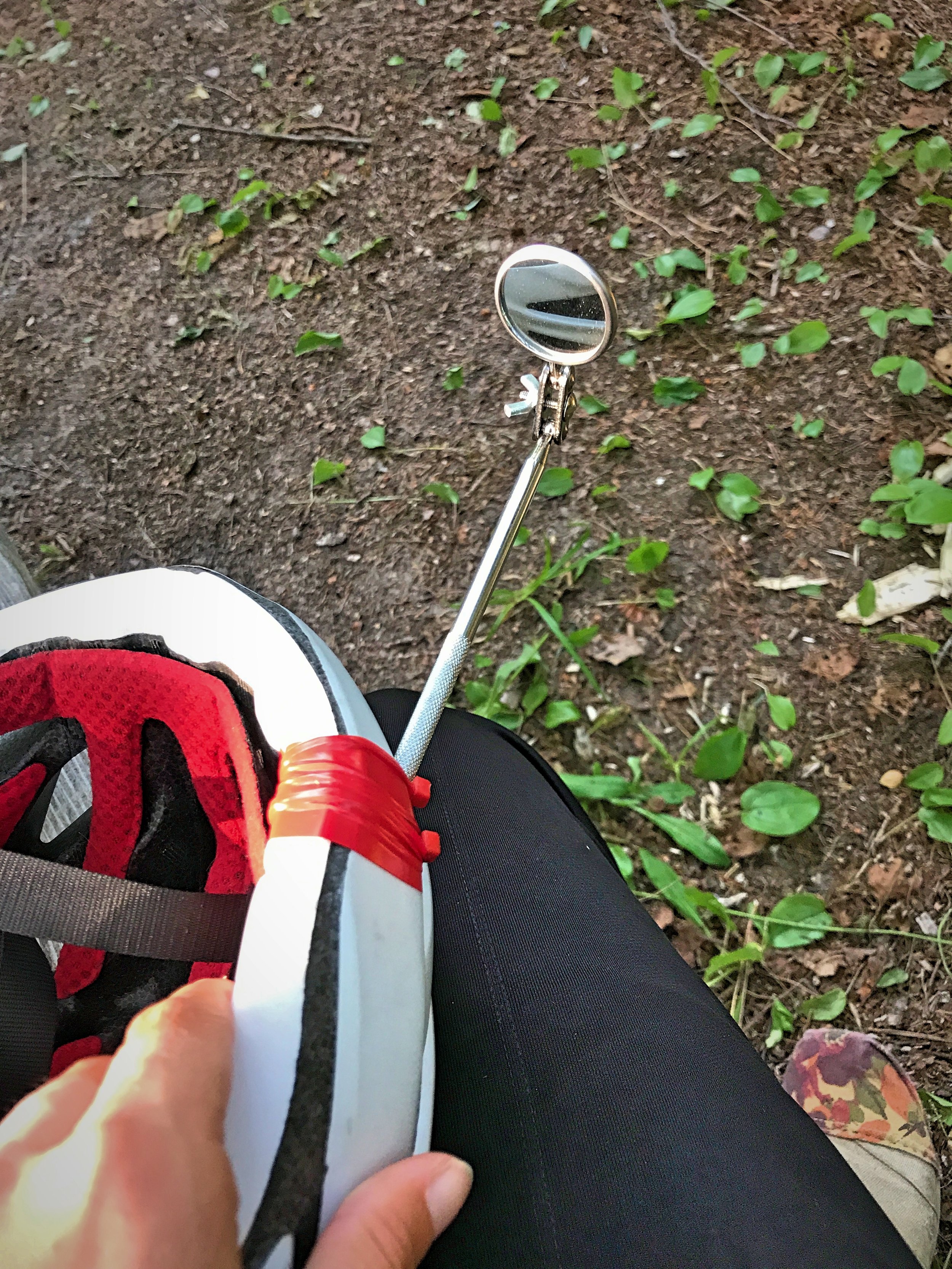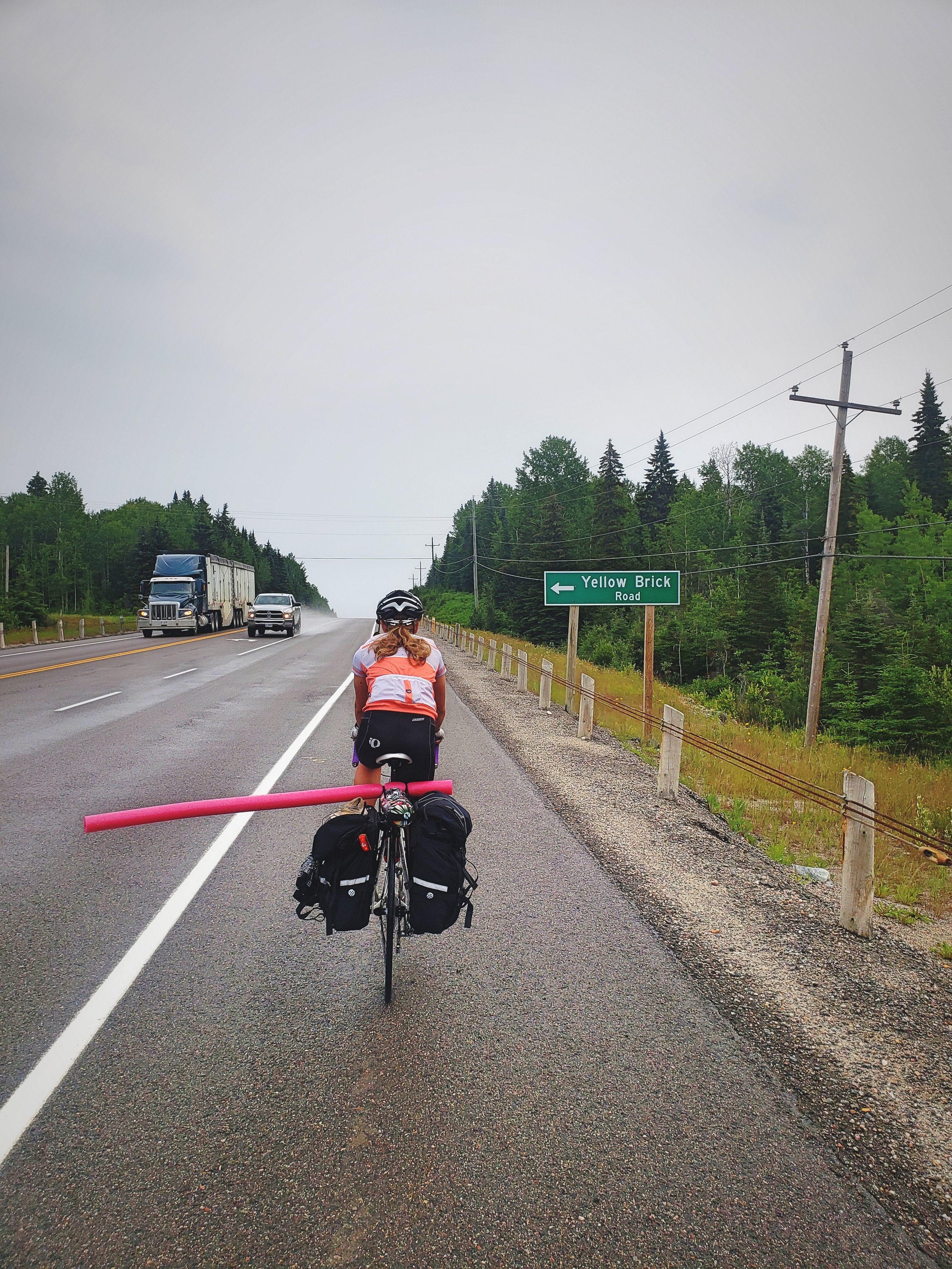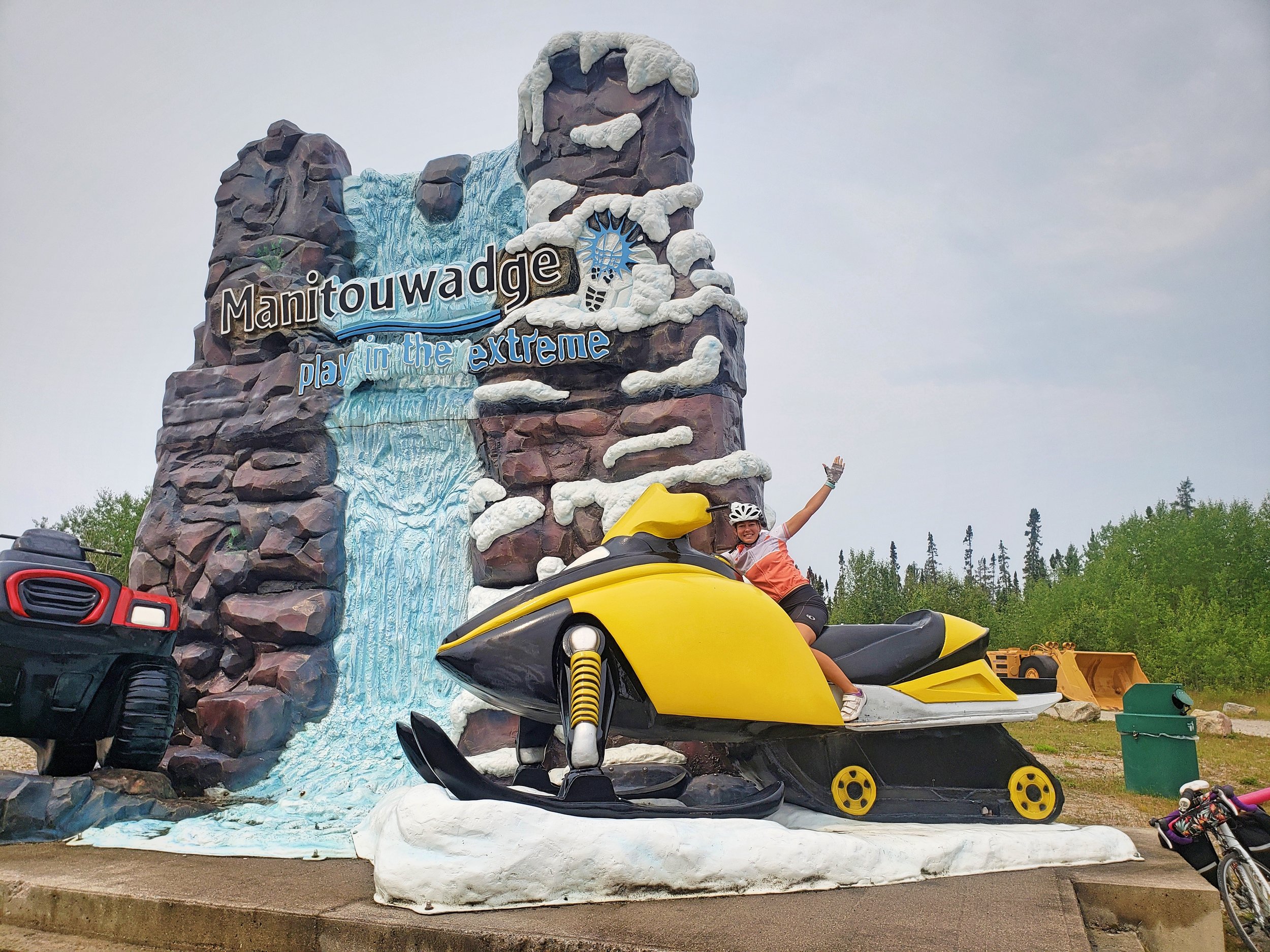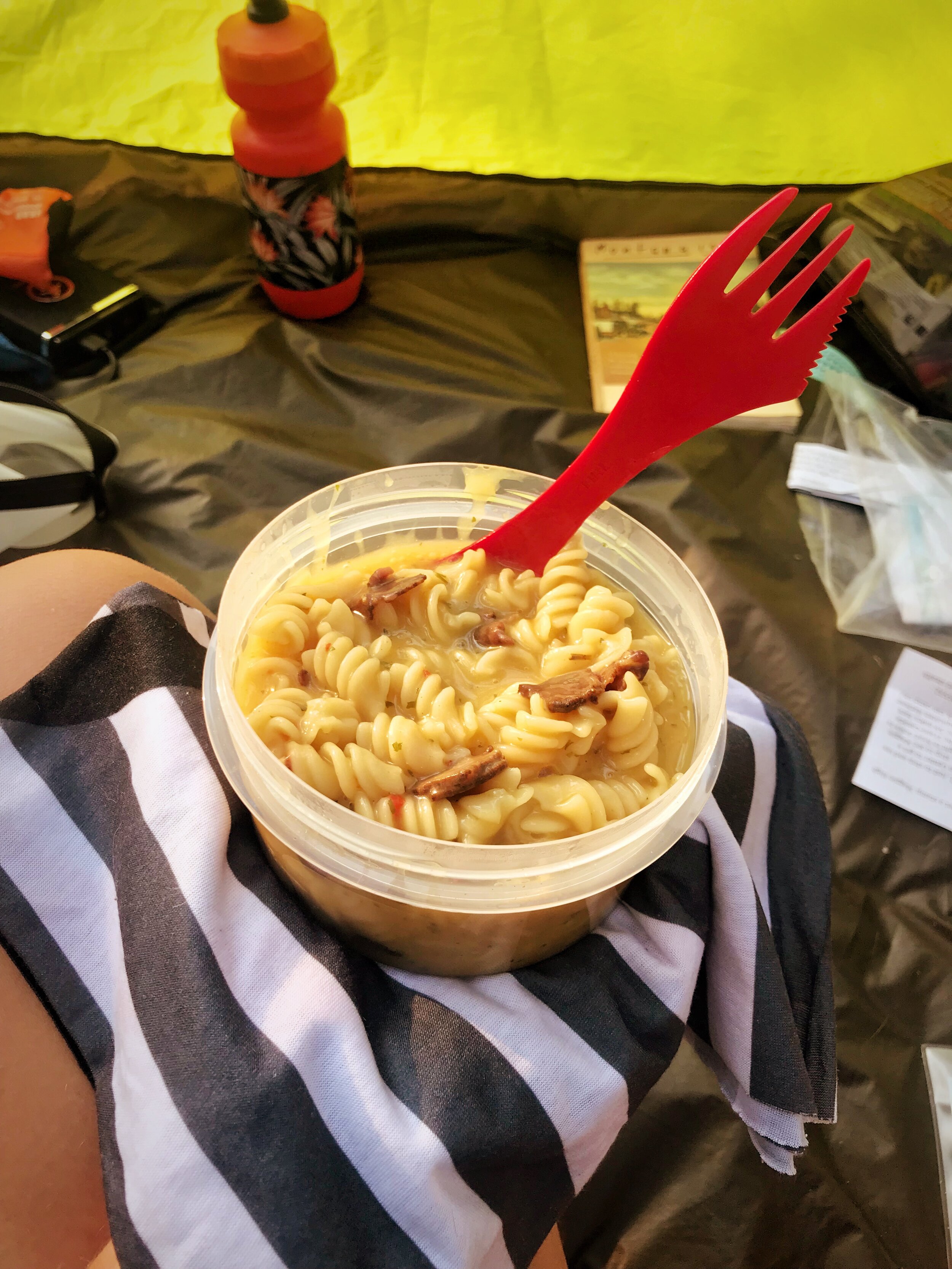Day 10- Lake Superior Circle Tour: Marathon to White River
Day 10
Leaving Pebble Beach in Marathon, Ontario on the morning of Day 10 was chilly. We even wore our jackets while biking up the three miles to the Trans-Canada Highway. By the time we had climbed the long steady hill back up to the highway, we had already warmed up.
Pebble Beach in Marathon, Ontario was one of our favorite beaches on the Lake Superior Circle Tour.
This little free campsite above the beach was one of our favorite free campsites around Lake Superior.
From the turn off to Marathon, we headed east on our bikes, keeping Lake Superior on our right as always.
When I planned the route for our Lake Superior Bike Tour, I had planned for us to go to Pukaskwa National Park, which is supposed to be an incredibly beautiful place to hike and explore the wild rocky shore and driftwood beaches.
It’s critical to have a rearview cycling mirror while biking on the Trans-Canada Highway.
If you lose your mirror in the sand on the beach, you have to tape a mechanic’s mirror to your helmet.
However, biking on the Trans-Canada Highway had really worn us down emotionally and physically, and the thought of biking an additional 20 miles to get to the park was too much for us. Plus we didn’t have the extra energy to hike once we got there anyway. So instead of taking the spur to Pukaskwa National Park, we passed it and headed straight for White River.
Logging is the primary industry in this region, and a gold mine recently opened nearby as well. This meant we were sharing the pavement with logging and mining trucks, but they weren’t really doing the same for us.
In this region of Ontario, the primary industries are logging and mining, so there is a lot of truck traffic that cyclists need to watch out for on the Trans-Canada.
Whenever we saw a truck coming up behind us and there was also oncoming traffic, we would just preemptively get off the highway and bail onto the gravel. We had learned that the trucks won’t slow down to pass cyclists, though they will get over if the other lane is clear.
Cars on the Trans-Canada might actually be worse than the trucks. It’s harder for the truckers to slow such a large mass, but with a car, there is really no excuse for them not to either get over or slow down.
Follow the Yellow Brick Road!
In the morning it was on-and-off rainy and quite cold. Just wet enough for the cars to spray us with a froth of road water as they passed, yet fortunately not rainy enough to threaten visibility. We always biked with flashing red rear lights on our panniers to make us more visible to drivers.
As the day progressed, it became hot and muggy. From Marathon to White River, the Trans-Canada is miles inland from the lake. Not tempered by the thermal mass of the lake, the climate is less mild. White River claims to be the “coldest spot in Canada,” though it isn’t even the coldest place in Ontario, let alone Canada.
This stretch of the Lake Superior Circle Tour is one of the most boring areas.
There are a number of giant fiberglass replicas on this part of the Lake Superior Circle Tour.
Being away from the coolness of the lake, the summers are less mild as well. The further inland we pedaled, the environment became, hotter and drier. The forest seemed lower and scrubbier. It was hot and dusty, and the closer we got to White River, the more that the truck traffic intensified.
We stumbled across a weird roadside attraction with a giant four-wheeler and snowmobile, which advertises Manitouwadge, a small town nearly 50km away. It was also surrounded by a graveyard of retired mining equipment.
Day 10 of our Lake Superior Circle Tour started out rainy.
This was not the only giant snowmobile statue that we discovered on the Lake Superior Circle Tour.
We reached White River, Ontario around mid-afternoon, and there really isn’t much to write home about. The town’s primary claim to fame is being the home of Winnie the Pooh—and even that is a bit of a stretch. White River is the home of the black bear that was taken to the London Zoo that inspired A.A. Milne to write Winnie the Pooh.
White River memorializes the inspiration to the childhood character with a kooky fiberglass roadside attraction that features Winnie the Pooh in a tree. One visitor noted “coming from either direction on Hwy 17, travelers would welcome the world's worst roadside attraction if it gave them a reason to get out of the car.”
After getting a selfie with Pooh, we went to check out the White River Tourist Information Center. The center is filled with Winnie the Pooh Memorabilia and the relics of logging camps.
White River, Ontario is the home of Winnie the Pooh, or at least the bear that inspired Winnie the Pooh. There’s also a free, but very bad free campground for cyclists.
The visitors center in White River offers free camping to cyclists on their grounds. But it’s not really a campsite so much as a very public patch of grass at the side of a parking lot in the middle of town. We had planned to camp here, but it was certainly not a place we would happily spend a night.
To make matters worse, the water in White River was contaminated by a landfill leak, so we didn’t know where we would get water if we camped there. In fact every town we had passed through since Terrace Bay had contaminated water. It was really affecting our ability to get enough water to drink. We were unsure if the landfill leak had also impacted the surface water the water from streams and lakes that we were gathering and treating to drink. There was no information online, and no one we asked knew any answers.
We decided to move on from White River, Ontario. It was only midday. Before leaving town we stopped at the A&W for some food, where we got half our order and some strange ice cream that was like a frozen hockey puck. Basically White River is a grim and regrettable place that can’t even be redeemed by ice cream.
It was so hilly, hot, and dusty as we rode drearily away from Winnie the Pooh’s birthplace. Eighteen-wheelers whizzed past us at 80 miles per hour. We were certainly feeling dejected as we continued our bike tour east on the Trans-Canada highway.
The rest area had a nice open picnic area where we set up our tent.
We took a little dip in this small river near the rest area.
About 12 miles from White River, we found a rest area where we spent the night. It’s probably not a place where tent camping was technically allowed, but we were so tired that we went for it anyway.
This rest area is actually quite pretty. There’s a nice picnic area. It’s along a shallow river where we went and rinsed off as best we could. That was about the extent of the relaxation that we got though. Despite the grass being mowed, there were so many mosquitoes that it was nearly unbearable to be outside the tent. We frantically cooked dinner over our tiny campstove with our mosquito head nets on.
The rest area is pretty close to the highway and even closer to the train tracks.
The rest area is actually quite pretty, and there were brand new pit toilets even.
Fortunately, the rest area had new plastic, modular pit toilets. At least our butts didn’t get bit up to much as we had experienced at other campsites along our Lake Superior Bike Tour. Saddle rash becomes much worse when you have 30 mosquito bites on top of it.
It was too hot to put the rainfly on the tent, so our tent was completely transparent. When the occasional car pulled into the rest area we would awkwardly nod as we sat cross-legged in the tent eating a dinner of Pasta Sides and biltong. After cycling 60 miles with a white-knuckled grip along the Trans-Canada Highway, you get to a point where you just don’t care about first impressions.
We ate a dinner of past a sides, biltong, and day-old muffins that we bought in Marathon.
We did not have a very restful night with the train rumbling past multiple times during the night.
Due to our severe exhaustion, we would have probably slept well here, despite our lack of stealth. However, unbeknownst to us there were train tracks only a few meters back in the woods from the rest area, and every hour or so a freight train roared terrifyingly past our camp.
See our full route on Strava!
POSTS ALSO TAGGED:
AEROTECH DESIGNS, BEACHES, Bike Clothing, BIKE MIRRORS, BIKE ROUTES, BIKE SAFETY, BIKE TOUR PLANNING, BIKE TOURING, BIKING, Biltong, Camp food, CAMPING GEAR, CANADA, COBBLE BEACHES, CYCLING GEAR, FREE CAMPING, FRUGAL TRAVEL, GREAT LAKES, HIGHWAY 17, History, LAKE SUPERIOR, LAKE SUPERIOR CIRCLE TOUR, MARATHON, Manitouwadge, NORTH SHORE, ONTARIO, Parks Canada, Pebble Beaches, PUBLIC LAND, Pukaskwa National Park, Roadside Attractions, STEALTH CAMPING, TENTS, TRAINS, TRANS-CANADA HIGHWAY, TRAVEL, White River, WILDERNESS
Have you done the Lake Superior Circle Tour or biked on the Trans-Canada Highway? Share your experience below.



















